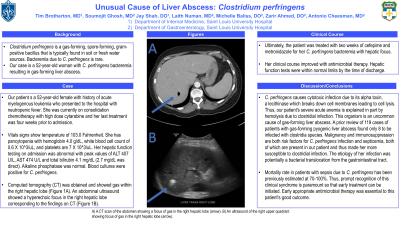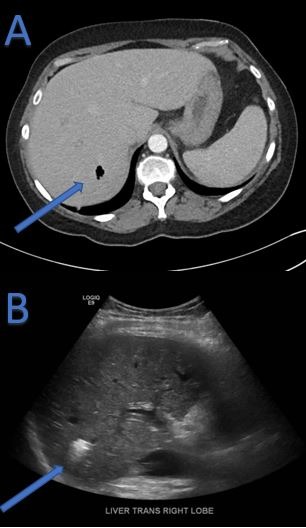Back


Poster Session E - Tuesday Afternoon
Category: Liver
E0529 - Unusual Cause of Liver Abscess: Clostridium perfringens
Tuesday, October 25, 2022
3:00 PM – 5:00 PM ET
Location: Crown Ballroom

Has Audio
- TB
Tim Brotherton, MD
Saint Louis University
St. Louis, Missouri
Presenting Author(s)
Tim Brotherton, MD, Soumojit Ghosh, MD, Jay Shah, MD, Laith Numan, MD, Michelle Baliss, DO, Zarir Ahmed, DO, Antonio Cheesman, MD
Saint Louis University, St. Louis, MO
Introduction: Clostridium perfringens is a gas-forming, spore-forming, gram-positive bacillus that is typically found in soil or fresh water sources. Bacteremia due to C. perfringens is rare. Our case is a 52-year-old woman with C. perfringens bacteremia resulting in gas-forming liver abscess.
Case Description/Methods: Our patient was a 52-year-old female with history of acute myelogenous leukemia who presented to the hospital with neutropenic fever. She was currently on consolidation chemotherapy with high dose cytarabine and her last treatment was four weeks prior to admission. Vitals signs show temperature of 103.0 Fahrenheit. She has pancytopenia with hemoglobin 4.0 g/dL, white blood cell count of 0.6 X 10^3/uL, and platelets are 7 X 10^3/uL. Her hepatic function testing on admission was abnormal with peak values of ALT 407 U/L, AST 474 U/L and total bilirubin 4.1 mg/dL (2.7 mg/dL was direct). Alkaline phosphatase was normal. Blood cultures were positive for C. perfringens. Computed tomography (CT) was obtained and showed gas within the right hepatic lobe (Figure 1A). An abdominal ultrasound showed a hyperechoic focus in the right hepatic lobe corresponding to the findings on CT (Figure 1B).
Ultimately, the patient was treated with two weeks of cefepime and metronidazole for her C. perfringens bacteremia with hepatic focus. Her clinical course improved with antimicrobial therapy. Hepatic function tests were within normal limits by the time of discharge.
Discussion: C. perfringens causes cytotoxic infection due to its alpha toxin, a lecithinase which breaks down cell membranes leading to cell lysis. Thus, our patient's severe acute anemia is explained in part by hemolysis due to clostridial infection. This organism is an uncommon cause of gas-forming liver abscess. A prior review of 119 cases of patients with gas-forming pyogenic liver abscess found only 8 to be infected with clostridia species. Malignancy and immunosuppression are both risk factors for C. perfringens infection and septicemia, both of which are present in our patient and thus made her more susceptible to clostridial infection. The etiology of her infection was potentially a bacterial translocation from the gastrointestinal tract.
Mortality rate in patients with sepsis due to C. perfringens has been previously estimated at 70-100%. Thus, prompt recognition of this clinical syndrome is paramount so that early treatment can be initiated. Early appropriate antimicrobial therapy was essential to this patient's good outcome.

Disclosures:
Tim Brotherton, MD, Soumojit Ghosh, MD, Jay Shah, MD, Laith Numan, MD, Michelle Baliss, DO, Zarir Ahmed, DO, Antonio Cheesman, MD. E0529 - Unusual Cause of Liver Abscess: Clostridium perfringens, ACG 2022 Annual Scientific Meeting Abstracts. Charlotte, NC: American College of Gastroenterology.
Saint Louis University, St. Louis, MO
Introduction: Clostridium perfringens is a gas-forming, spore-forming, gram-positive bacillus that is typically found in soil or fresh water sources. Bacteremia due to C. perfringens is rare. Our case is a 52-year-old woman with C. perfringens bacteremia resulting in gas-forming liver abscess.
Case Description/Methods: Our patient was a 52-year-old female with history of acute myelogenous leukemia who presented to the hospital with neutropenic fever. She was currently on consolidation chemotherapy with high dose cytarabine and her last treatment was four weeks prior to admission. Vitals signs show temperature of 103.0 Fahrenheit. She has pancytopenia with hemoglobin 4.0 g/dL, white blood cell count of 0.6 X 10^3/uL, and platelets are 7 X 10^3/uL. Her hepatic function testing on admission was abnormal with peak values of ALT 407 U/L, AST 474 U/L and total bilirubin 4.1 mg/dL (2.7 mg/dL was direct). Alkaline phosphatase was normal. Blood cultures were positive for C. perfringens. Computed tomography (CT) was obtained and showed gas within the right hepatic lobe (Figure 1A). An abdominal ultrasound showed a hyperechoic focus in the right hepatic lobe corresponding to the findings on CT (Figure 1B).
Ultimately, the patient was treated with two weeks of cefepime and metronidazole for her C. perfringens bacteremia with hepatic focus. Her clinical course improved with antimicrobial therapy. Hepatic function tests were within normal limits by the time of discharge.
Discussion: C. perfringens causes cytotoxic infection due to its alpha toxin, a lecithinase which breaks down cell membranes leading to cell lysis. Thus, our patient's severe acute anemia is explained in part by hemolysis due to clostridial infection. This organism is an uncommon cause of gas-forming liver abscess. A prior review of 119 cases of patients with gas-forming pyogenic liver abscess found only 8 to be infected with clostridia species. Malignancy and immunosuppression are both risk factors for C. perfringens infection and septicemia, both of which are present in our patient and thus made her more susceptible to clostridial infection. The etiology of her infection was potentially a bacterial translocation from the gastrointestinal tract.
Mortality rate in patients with sepsis due to C. perfringens has been previously estimated at 70-100%. Thus, prompt recognition of this clinical syndrome is paramount so that early treatment can be initiated. Early appropriate antimicrobial therapy was essential to this patient's good outcome.

Figure: A) A CT scan of the abdomen showing a focus of gas in the right hepatic lobe (arrow).
B) An ultrasound of the right upper quadrant showing focus of gas in the right hepatic lobe (arrow).
B) An ultrasound of the right upper quadrant showing focus of gas in the right hepatic lobe (arrow).
Disclosures:
Tim Brotherton indicated no relevant financial relationships.
Soumojit Ghosh indicated no relevant financial relationships.
Jay Shah indicated no relevant financial relationships.
Laith Numan indicated no relevant financial relationships.
Michelle Baliss indicated no relevant financial relationships.
Zarir Ahmed indicated no relevant financial relationships.
Antonio Cheesman indicated no relevant financial relationships.
Tim Brotherton, MD, Soumojit Ghosh, MD, Jay Shah, MD, Laith Numan, MD, Michelle Baliss, DO, Zarir Ahmed, DO, Antonio Cheesman, MD. E0529 - Unusual Cause of Liver Abscess: Clostridium perfringens, ACG 2022 Annual Scientific Meeting Abstracts. Charlotte, NC: American College of Gastroenterology.
